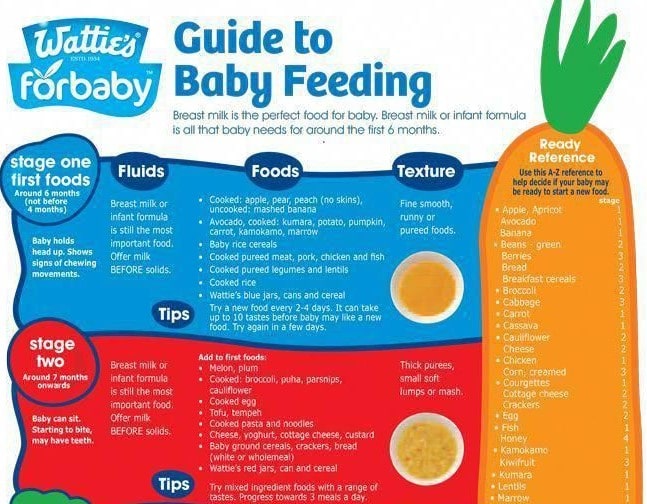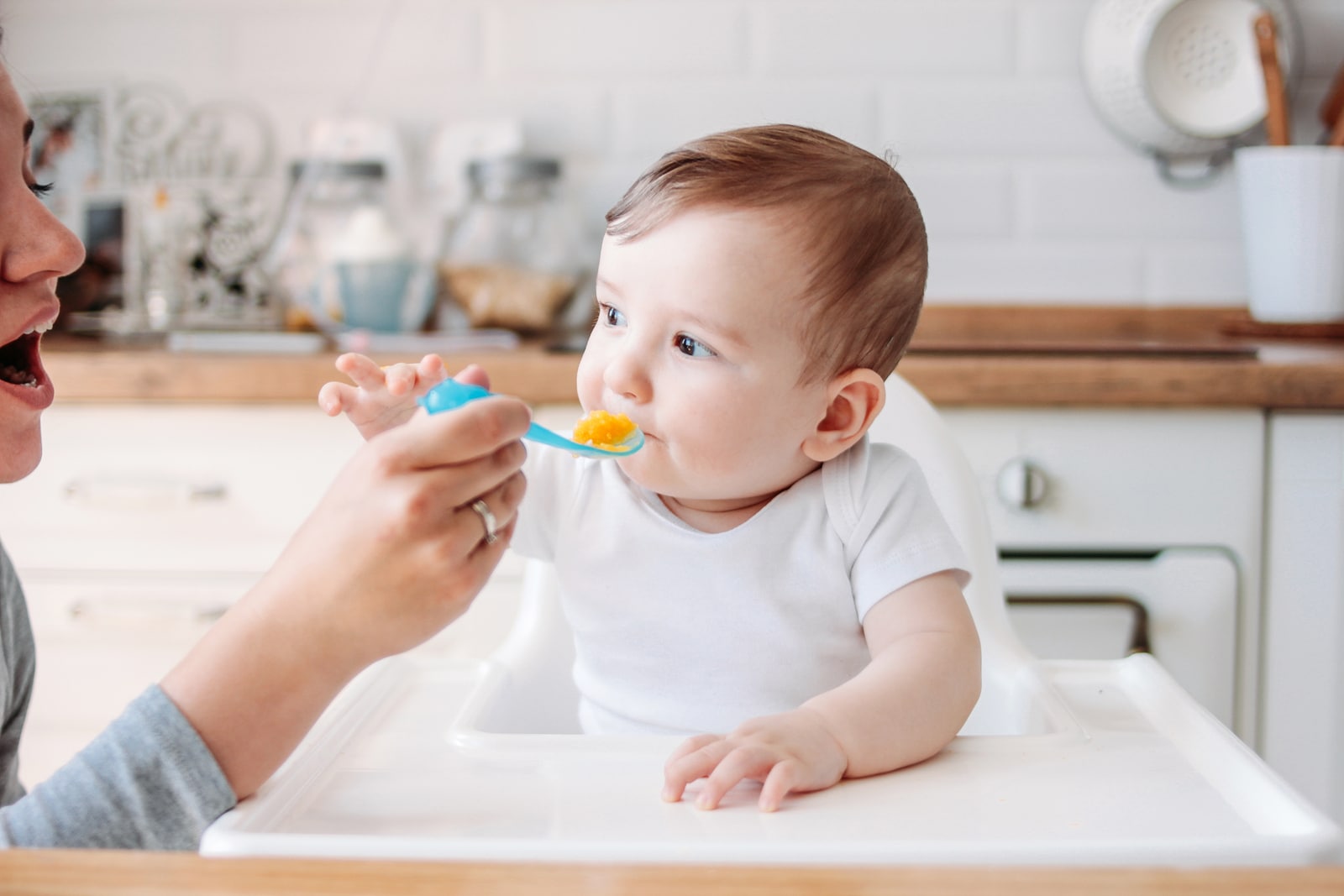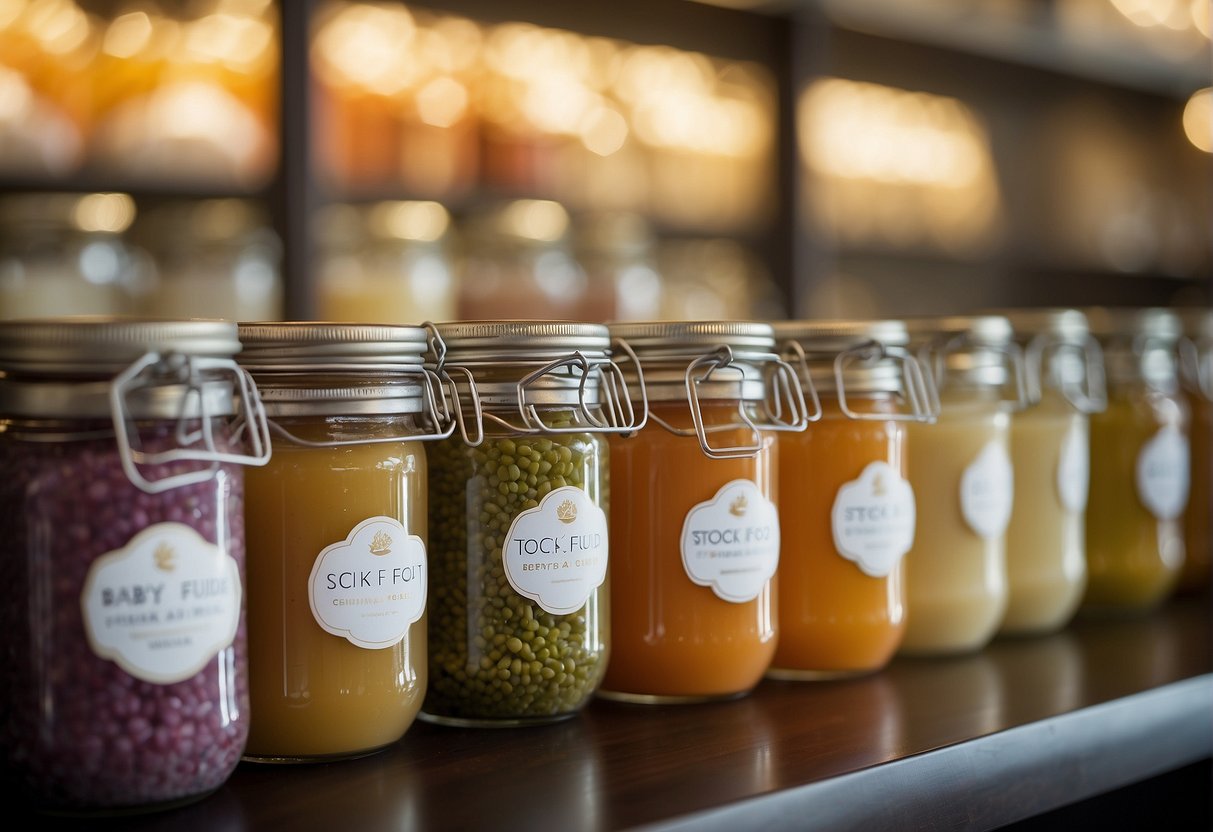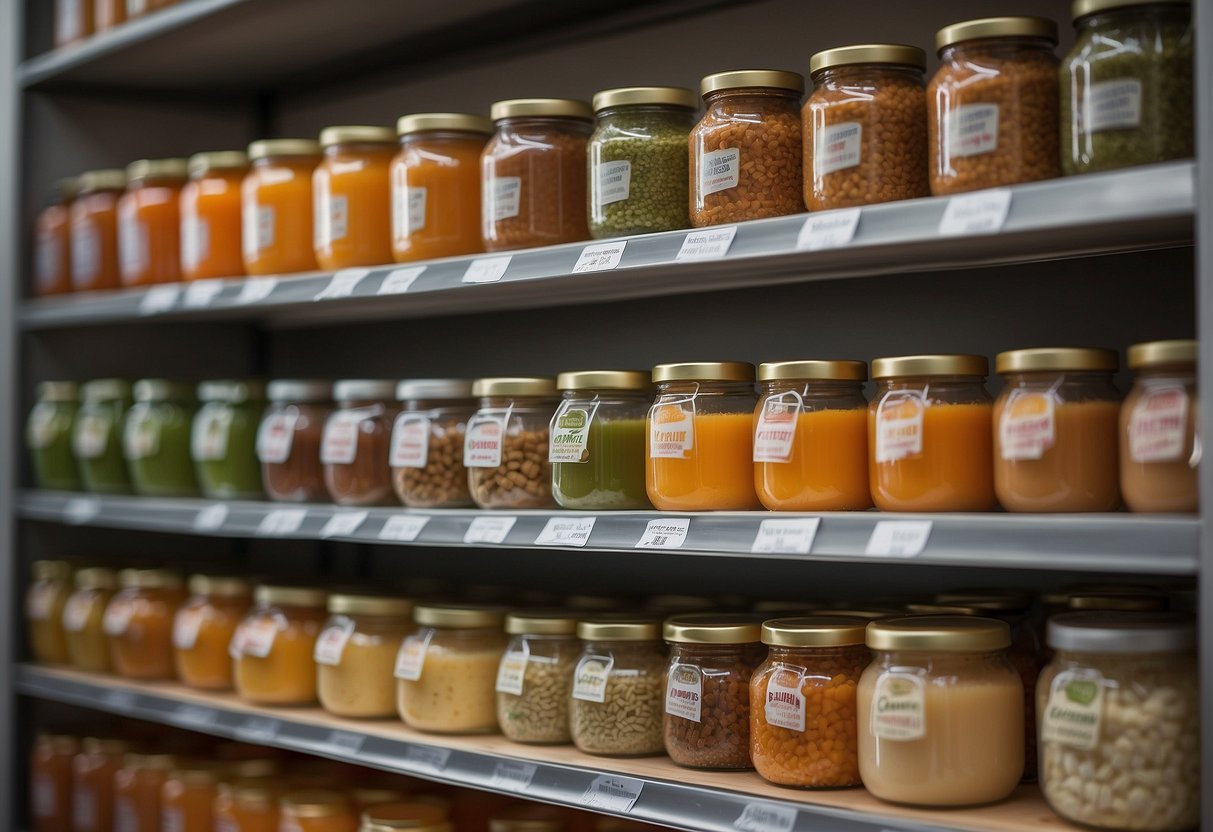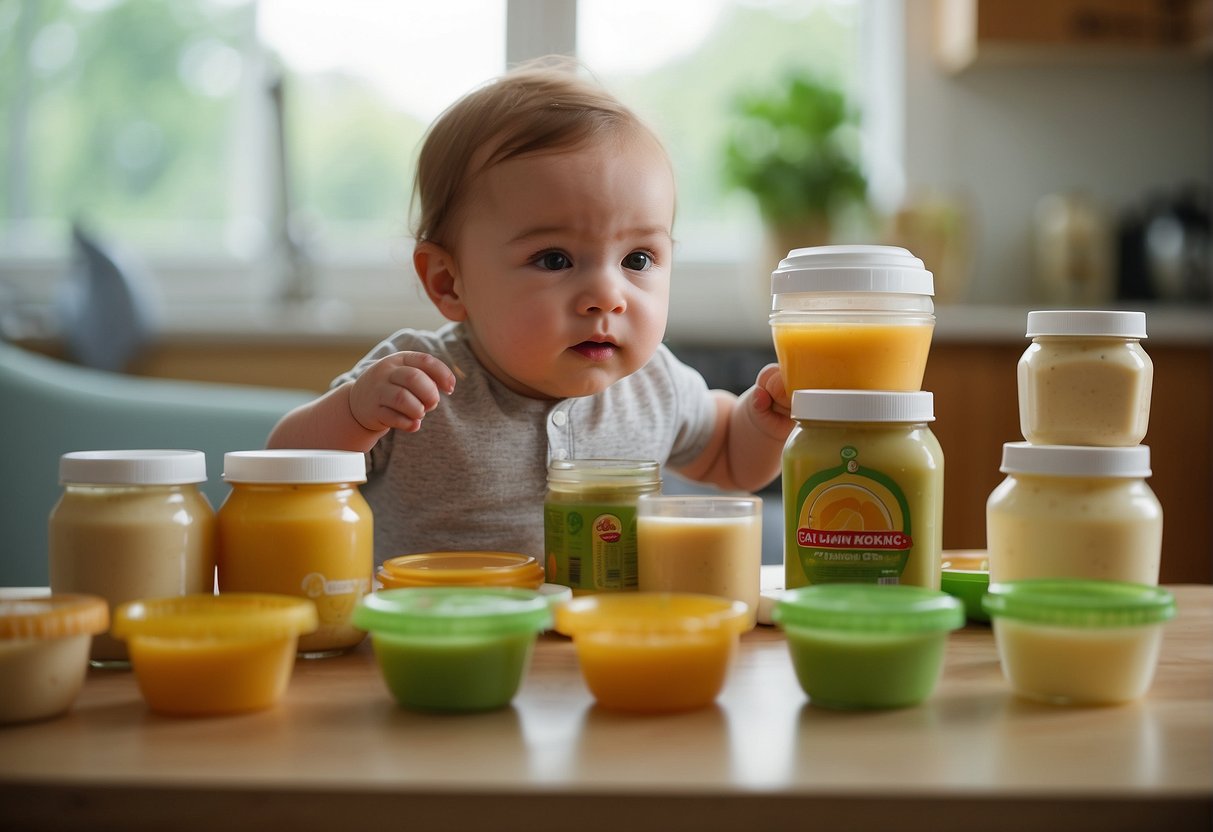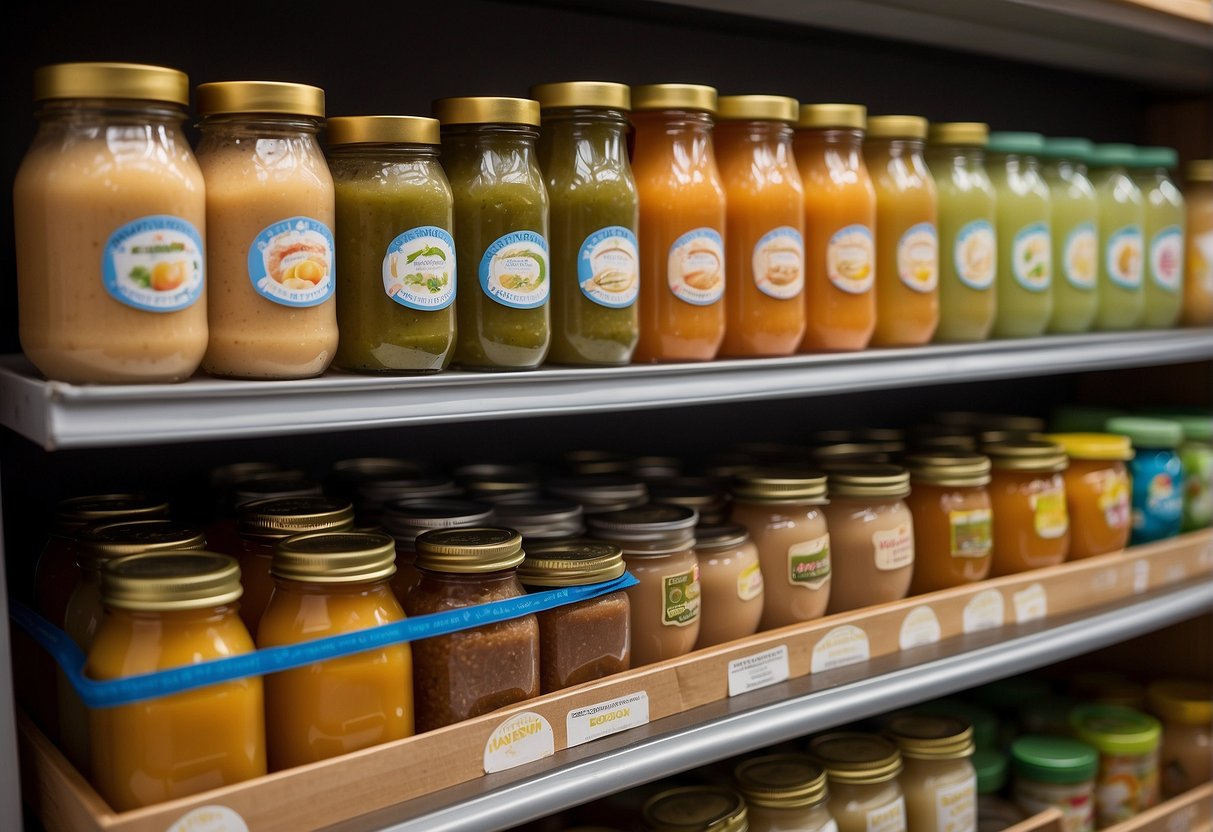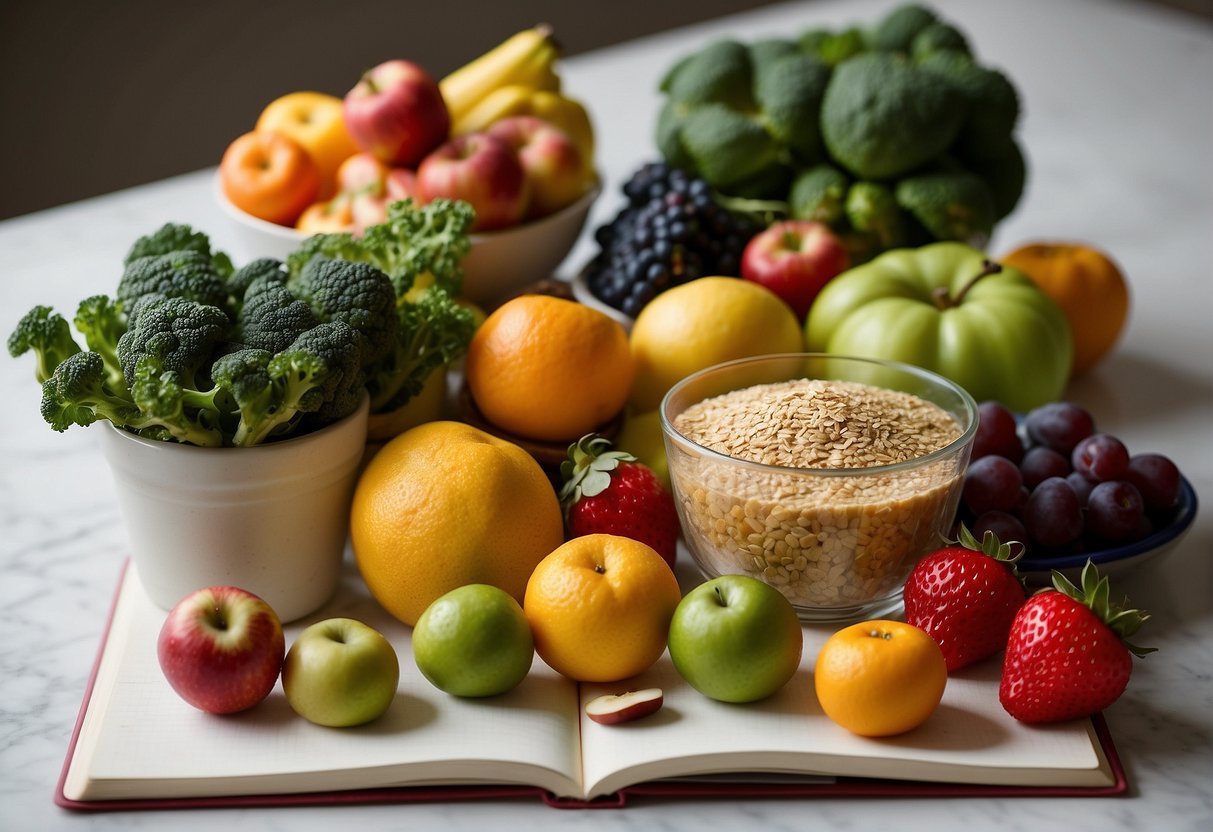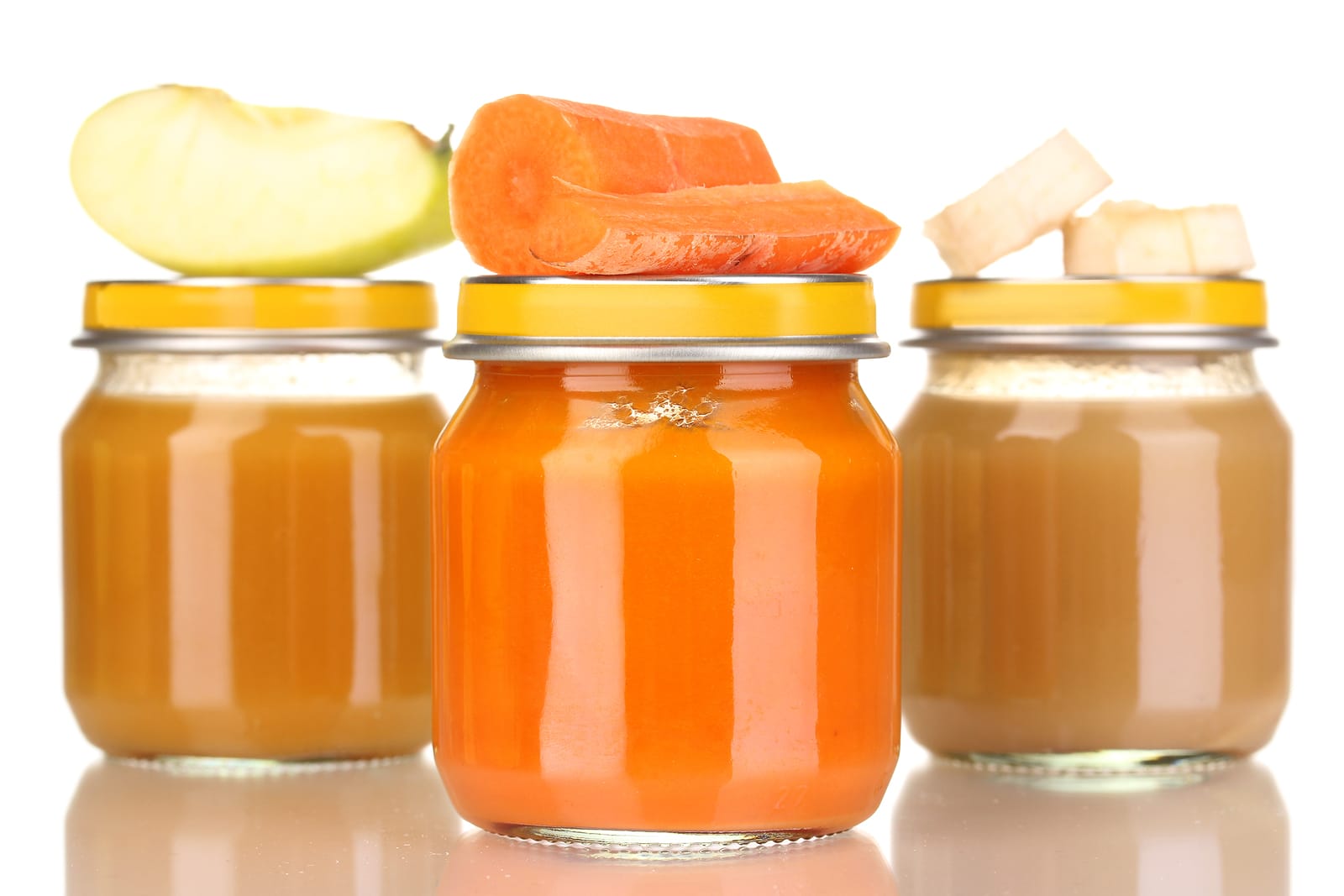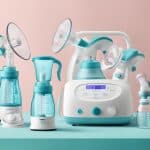Navigating the world of baby food can be overwhelming for new parents. With a plethora of options available on the market and a growing concern for providing the best nutrition possible, it’s essential to know what to look for in store-bought baby foods. A well-informed buyer’s guide serves as an invaluable tool in making these important decisions, ensuring that your little one gets started on a healthy, balanced diet.
Understanding the nutritional needs of your baby as they transition into solid foods is crucial for their growth and development. Exploring various product types, reading labels, and considering different brands while keeping in mind any allergies or sensitivities your baby may have, will make the process smoother. In addition, finding the right balance between diet diversity, meal planning, and budgeting helps parents make informed choices that fit into their lifestyle and cultural preferences.
Key Takeaways
- A baby food buyer’s guide helps parents navigate the variety of options and make informed choices for their child’s nutrition.
- Understanding your baby’s nutritional needs, considering product types, and reading labels are essential aspects of selecting the right baby food.
- Balancing diet diversity, meal planning, and budgeting ensures that your baby receives a well-rounded and culturally appropriate diet that fits your lifestyle.
Understanding Baby Food
What Is Baby Food?
Baby food is a category of nutritional products designed specifically for infants and young toddlers. Typically, it consists of purees and soft, easy-to-digest ingredients that cater to the developmental needs and dietary restrictions of babies.
From birth to approximately 6 months, babies receive all the necessary nutrition from breast milk or formula. As they grow and develop, solid foods are gradually introduced to their diet to provide a diverse range of nutrients and flavors.
Baby food can be divided into stages based on a baby’s age and development:
- Stage 1: Purees with a thin consistency, suitable for babies aged 4-6 months.
- Stage 2: Thicker purees and mashed foods, ideal for babies aged 6-8 months.
- Stage 3: Chunkier textures and finger foods, suitable for babies aged 9-12 months.
Types of Baby Food
When it comes to baby food types, there are several options available for parents to choose from, including store-bought and homemade varieties:
-
Purees: These are smooth, mashed foods made from fruits, vegetables, and proteins such as meat or fish. Purees are typically the first solid foods introduced to a baby’s diet and can be found in stage 1 and stage 2.
-
Cereals: Infant cereals are often made from rice, oats, or barley and mixed with breast milk or formula to achieve a smooth consistency. However, it is advisable to limit rice-based infant cereals due to concerns about high arsenic levels.
-
Finger Foods: As babies transition to more solid foods, they can begin to explore foods that can be grasped and eaten with fingers. Soft fruits, cooked vegetables, and age-appropriate snacks come under this category.
-
Formula: Infant formula is a manufactured food designed to mimic the composition of breast milk. It provides essential nutrients and is typically fed as a liquid using a bottle.
-
Breast Milk: Considered the optimal source of nutrition for infants, breast milk is a natural option that provides a balanced mix of nutrients for a baby’s growth and development.
When selecting store-bought baby food, it is essential to pay attention to the ingredients and choose nutrient-dense options. Homemade baby food allows for greater control over ingredients and allows parents to customize their baby’s diet according to individual preferences and needs.
Starting Solids: When and How
Recognizing Readiness
Introducing solid foods to your baby is an important milestone. Typically, babies can start solids around 6 months old. It is essential to recognize your baby’s developmental milestones to ensure they are ready for solids. Some signs of readiness include:
- Sitting up without support: Your baby should be able to sit up independently, either in a high chair or on the floor with minimal to no support.
- Head and neck control: Your baby must have good head and neck control to safely swallow solid foods.
- Showing interest in food: Watch for your baby reaching out for or trying to grab food when others are eating.
- Ability to move food to the back of the mouth: Your baby should be able to move food using their tongue without pushing it out of their mouth.
Always consult your pediatrician before starting solids to ensure your baby is developmentally ready.
First Foods to Introduce
When introducing solids, start with single-ingredient, simple foods. These can include pureed or mashed fruits, vegetables, and iron-fortified single-grain cereals. Here are some examples:
- Iron-fortified single-grain cereals: Rice, oatmeal, or barley cereals can be prepared with breast milk or formula. These cereals provide your baby with much-needed iron at this stage. However, avoid feeding your baby only rice cereal due to possible exposure to arsenic.
- Fruits and vegetables: Start with pureed or well-mashed fruits and vegetables, such as bananas, apples, sweet potatoes, and carrots. You can either buy pre-made baby food or make your own at home.
- Meats and proteins: Once your baby gets comfortable with cereals, fruits, and vegetables, gradually introduce pureed meats like chicken, turkey, or beef, as well as protein alternatives like beans or peas.
Remember to introduce new foods one at a time, spaced out by 3-5 days. This will help you identify any potential food allergies or digestive issues related to a specific food.
Nutritional Considerations
Essential Nutrients
When choosing baby foods, it is vital to consider the essential nutrients that an infant needs for proper growth and development. These nutrients include iron, protein, healthy fats, and vitamins.
Iron is a crucial nutrient for infants, particularly during the first year. Breastfed babies need an additional source of iron, such as iron-fortified cereals, starting at around 6 months of age. Formula-fed babies also benefit from iron-enriched formulas to ensure they receive an adequate supply.
Protein is essential for a child’s growth and development. Sources of protein for an infant may include lean meats, poultry, and beans. It is recommended that infants receive enough protein from a variety of food sources for a balanced diet.
Healthy fats are necessary for a baby’s brain development and overall health. These can be found in breast milk or formula, as well as in foods such as avocados, whole fat yogurt, and olive oil.
Vitamins play a crucial role in maintaining a child’s health. Ensuring that the baby receives a variety of fruits and vegetables will help provide essential vitamins, such as vitamins A, C, and D.
Customizing Nutrition to the Child
Each child is unique and may have different nutritional needs or preferences. To ensure the best possible nutrition for your child, it’s essential to customize their diet based on their age, health history, and overall needs5. This can be achieved through a combination of breastfeeding, formula feeding, and gradually introducing solid foods6.
Tailoring your baby’s diet based on their needs, in consultation with a healthcare professional, can help promote healthy growth and set the foundation for a lifetime of proper nutrition.
Footnotes
Choosing the Right Baby Food
Commercial vs. Homemade Baby Food
Both commercial and homemade baby food have their pros and cons. Store-bought baby food can be convenient due to its long shelf life and wide variety. However, it’s important to be vigilant about the ingredients to ensure the baby is getting the best nutrition possible. On the other hand, making homemade baby food allows for more control over the ingredients while potentially being more cost-effective. It’s worth considering a combination of both, buying some pre-made food and making some at home.
Evaluating Baby Food Brands
When choosing baby food brands, it’s crucial to pay attention to factors like:
- Organic vs. non-organic: Organic ingredients are typically preferable as they are grown without harmful pesticides or chemicals, ensuring a healthier option for babies.
- Non-GMO: Non-genetically modified ingredients reduce the risk of exposure to harmful substances and allergens.
- Ingredients: The order in which ingredients are listed signifies their proportion in the product. Always look for nutrient-dense foods and avoid any unnecessary fillers.
- Added sugars and preservatives: Opt for brands that have no added sugars and avoid artificial preservatives.
Ingredients to Look For and Avoid
Here is a list of ingredients to look for and those to avoid in baby food:
| Look For | Avoid |
|---|---|
| Organic ingredients | Added sugars |
| Non-GMO | Artificial preservatives |
| Nutrient-dense foods | Heavy metals ^1^ Ingredients |
| Unsweetened foods | Unnecessary fillers |
In summary, choose baby food that is made with organic and non-GMO ingredients and has no added sugars or artificial preservatives. Be cautious of unnecessary fillers and heavy metals, and always pay attention to the order of ingredients listed. Combining store-bought and homemade baby food can provide the best of both worlds, offering convenience and control over ingredients.
Feeding Techniques and Practices
When introducing solid foods to your baby, there are two popular methods: Baby-Led Weaning and Traditional Weaning. Both techniques have their benefits and can be adapted to suit each child’s needs and developmental stage. It’s important to follow a feeding guide and pay close attention to your baby’s cues to ensure a smooth transition.
Baby-Led Weaning
Baby-Led Weaning (BLW) is a method that encourages infants to self-feed with finger foods, rather than relying on spoon-fed purees. This approach can help babies develop motor skills and allow them to explore different textures and flavors at their own pace. Some popular BLW foods include:
- Soft fruits and vegetables (e.g., avocado, ripe banana, steamed broccoli)
- Toast or rice cakes
- Cooked egg
It’s essential to offer age-appropriate foods, ensuring that they are soft and easy to chew. Monitor your baby when they’re trying new textures to avoid potential choking hazards. The CDC’s infant and toddler nutrition guidelines can be a useful resource.
Traditional Weaning
Traditional weaning, the more conventional method, involves gradually introducing pureed and mashed foods to the baby. This method usually starts with single-ingredient purees, such as:
- Pureed fruit (e.g., applesauce, pear, plum)
- Pureed vegetables (e.g., carrot, sweet potato, peas)
- Pureed meat or beans
With traditional weaning, it is recommended to introduce one new food at a time and wait for 2-3 days before adding another new food. This helps identify any potential allergies or intolerances. As your baby’s ability to chew and swallow improves, you can slowly introduce more complex textures like minced, mashed, or finely chopped foods.
Both Baby-Led Weaning and Traditional Weaning can be effective in helping your baby transition to solid foods. It’s crucial to observe your child and follow their feeding cues to ensure they receive adequate nutrition. Always consult a healthcare professional for specific advice regarding your baby’s nutritional needs.
Safety and Allergy Considerations
Identifying and Preventing Food Allergies
Food allergies are a concern for many parents, as they affect between 4% and 8% of children in the United States. Introducing allergenic foods to your baby needs to be done carefully and systematically to ensure safety and well-being. Here are a few tips to help you with this process:
- Start with low-risk foods. Begin by introducing foods that are less likely to cause an allergic reaction, such as avocados, bananas, and rice cereal.
- Introduce one food at a time. Wait for at least 3-5 days between each new food introduction to accurately identify possible reactions.
- Monitor for reactions. Keep an eye out for common allergy symptoms, such as rash, hives, nausea, and difficulty breathing.
- Consult your child’s doctor. If either biological parent has food allergies, discuss with your child’s doctor any special steps to take when introducing common food allergens, as suggested by this PDF Food Allergy Considerations for Infants and Toddlers.
Considering allergen-free alternatives can also be a wise option when feeding your baby. This helps in reducing the exposure to harmful allergens while still providing essential nutrients.
Food Safety Tips
Besides allergenicity, you should also consider food safety when selecting and preparing baby food. Here are a few tips to ensure your baby’s food is safe:
- Check for heavy metals. Be cautious of ingredients that may contain harmful heavy metals, such as arsenic, lead, and mercury. Many baby food options have been found to have traces of heavy metals. Limit such foods and opt for healthier alternatives.
- Store food properly. Always follow the recommended storage guidelines for baby food, such as refrigerating after opening, using proper storage containers, and promptly discarding any expired or spoiled food.
- Practice proper food handling. Wash your hands thoroughly before preparing food, and ensure that utensils and surfaces are clean. Also, make sure to cook raw meats and eggs properly to kill any harmful bacteria.
- Be mindful of choking hazards. Choose age-appropriate food textures and cut food into small, manageable pieces to minimize choking risks.
Product Types and Forms
Pouches, Jars, and Subscriptions
When it comes to baby food, there are various product types and forms available for parents to choose from. One popular option is baby food pouches. These are convenient because they are portable and can easily be carried in a diaper bag. Parents can squeeze the pureed fruits or vegetables directly onto a spoon for feeding. Baby food pouches are often available in various flavors, including stage 1 purees which contain a single ingredient and are ideal for infants starting solid foods, and stage 2 purees which contain a mix of fruits, vegetables, and sometimes grains for more variety and texture.
Jars are another common form of packaging for baby food. They usually contain infant cereals and purees and can be easily stored in the pantry. When shopping for jarred baby foods, be sure to pay attention to the order of ingredients to ensure optimal nutrition for your baby. Look for nutrient-dense ingredients and avoid unnecessary fillers.
In addition to pouches and jars, baby food subscriptions have become more popular in recent years. These services often deliver fresh, organic, and customizable purees or infant cereals tailored to your child’s current stage and preferences. Having a baby food subscription can save time and effort for busy parents by providing pre-portioned meals that can be easily consumed by their little ones.
Infant Cereals and Purees
Infant cereals are a common first food choice for parents starting their baby on solids. While rice-based infant cereals are a traditional option, it is recommended to limit rice-based cereals due to concerns about arsenic content. Instead, parents can opt for oat, barley, or multigrain cereals which provide more nutritional variety.
Pureed fruits and vegetables are essential for introducing babies to the tastes and textures of whole foods. Stage 1 purees usually consist of a single fruit or vegetable, while stage 2 purees may include a mix of different ingredients and offer more complex flavors. When shopping for purees, look for unsweetened versions and avoid those with added sugars.
In conclusion, when selecting baby food products, parents should consider product types, packaging, and ingredients to ensure their little ones receive the best nutrition possible.
Understanding Labels
Reading and Interpreting Labels
When selecting baby food, it is essential to understand how to read and interpret food labels. Labels provide important information about the ingredients, nutritional content, and potential allergens present in the food. Start by checking the list of ingredients, as they are listed in descending order by weight. This gives you an indication of the proportions of each ingredient in the product.
For example, if you’re looking for convenience and quality, you might want to choose baby food with organic ingredients and minimal additives. Look for products that mention their use of organic and non-GMO ingredients on the label to ensure the food is free from harmful chemicals and genetically modified organisms.
Next, examine the nutrition information to determine the levels of macronutrients (protein, fat, and carbohydrates) and micronutrients (vitamins and minerals) present in the food. This helps ensure that your baby is getting the essential nutrients needed for healthy growth and development. Here’s a sample food label:
| Nutrient | Amount per 100g |
|---|---|
| Energy | 98Kcal/411KJ |
| Protein | 4.3g |
| Carbohydrates | 12.5g |
| Fat | 3.2g |
| Fiber | 1.1g |
| Sodium | 45mg |
Certifications and Labels
In addition to the nutritional information and ingredients, be aware of certifications and labels on baby food packaging. There are voluntary certifications available for baby food products, such as the Organic and Non-GMO Project Verified labels, which can provide added assurance that the food meets specific quality standards.
-
Organic Certification: An organic label signifies that the baby food has been produced using organic methods, without the use of synthetic chemicals, and meets the standards set by an accredited organic certifying agency. This can mean reduced exposure to pesticides and other chemicals for your baby.
-
Non-GMO Project Verified: This label indicates that the product does not contain genetically modified organisms (GMOs). Choosing non-GMO baby food helps avoid potential health risks associated with GMOs and supports sustainable farming practices.
By understanding how to read and interpret baby food labels, you can make informed choices to ensure a healthy and balanced diet for your little one. Keep an eye out for labels highlighting the use of organic and non-GMO ingredients and be confident that you’re offering the highest quality food for your baby.
Diet Diversity and Meal Planning
Offering a Range of Foods
A well-rounded baby food plan should include a variety of fruits, vegetables, grains, and meats to ensure proper nourishment. Introducing a diverse range of foods not only provides essential nutrients, but also helps in developing your baby’s palette and preventing them from becoming too selective or having food aversions later in life.
When planning meals for your baby, consider incorporating different types of fruits and vegetables as they contain essential vitamins, minerals, and antioxidants. Green leafy vegetables, for example, are rich in iron, calcium, and vitamins A, C, and K. Similarly, fruits like berries, apples, and bananas offer a range of essential nutrients while adding natural sweetness to your baby’s meals.
Grains, as part of their diet, provide crucial carbohydrates and fiber necessary for their energy and digestive health. Choose whole grains such as brown rice, quinoa, and oats for added nutritional benefits. It’s also important to introduce a variety of proteins, such as meats, poultry, and fish, providing them with essential amino acids.
Scheduling Meals and Snacks
As babies grow and develop, it becomes necessary to create a structured meal plan that includes both main meals and optional healthy snacks. The timing of solid meals can vary, depending on both the baby’s and parent’s routine. However, it is crucial to ensure that breast milk or formula remains the primary source of nutrition until the baby is 1 year old.
Here’s a simple meal planning guideline for babies:
- 6-9 months: Begin with one solid meal a day, gradually moving to two meals a day.
- 9-12 months: Introduce three meals a day with the option of healthy snacks in between.
| Baby's Age | Meal Frequency | Snacks |
|----------------|------------------|----------------|
| 6-9 months | 1-2 meals a day | As Needed |
| 9-12 months | 3 meals a day | Optional/Healthy |
As your baby grows and becomes more adept at self-feeding, consider introducing lumpier food textures and soft finger foods to promote the development of their fine motor skills and let them explore diverse textures.
Brand Overview and Recommendations
Top-Rated Baby Food Brands
Several baby food brands are popular and well-regarded for their quality and taste. Some top-rated options include:
- Once Upon a Farm: This brand offers fresh, cold-pressed organic baby food made from non-GMO ingredients. Their flavorful blends are a hit with both parents and little ones.
- Plum Organics: Known for their nutrient-rich, organic food pouches, Plum Organics offers a wide variety of tasty options for babies and toddlers.
- Happy Baby: Happy Baby has a well-rounded line of products, including organic baby food pouches, snacks, and teething biscuits, making them a favorite among parents.
- Gerber Organic: A trusted veteran in the baby food industry, Gerber offers a range of high-quality organic options for infants and toddlers alike.
Subscription Services and Specialty Brands
For a more personalized and convenient approach, several subscription services and specialty brands have emerged. Some noteworthy options are:
- Cerebelly: This brand stands out for its nutrient-dense, brain-focused formulations, making it an appealing option for parents seeking the best for their child’s development.
- Little Spoon: Offering a baby food subscription service, Little Spoon delivers fresh meals on a customizable schedule, allowing parents to provide nutritious, age-appropriate food tailored to their child’s needs.
- Serenity Kids: Serenity Kids provides high-quality, nutrient-rich baby foods with a focus on Paleo principles and sustainability, ensuring your little one gets the best start possible.
Overall, research and personal preferences are essential to determine the best option for your little one. Considering factors like ingredients, nutritional values, and convenience will help you make an informed decision regarding the most suitable baby food brand for your needs.
Budgeting and Economic Considerations
Calculating Costs
When planning for baby food expenses, it’s important to estimate the quantity and types of food needed for your child. According to a comprehensive guide for baby formula budgeting, the average consumption for a newborn is 24-32 ounces per day, increasing to 32-36 ounces per day as they reach 1-2 months of age. Once your baby starts eating solid foods (around 4 to 6 months old), the monthly costs typically range from $60 to $135, based on the budgeting guide for new parents by The Penny Hoarder.
The table below presents the expenses associated with baby food:
| Age Range | Food Intake | Cost per Month |
|---|---|---|
| Newborn | 24-32 ounces of formula per day | Formula costs |
| 1-2 months | 32-36 ounces of formula per day | Formula costs |
| 4-6 months+ | Transition to solid foods (jars or pouches) | $60 to $135 |
Note: Formula costs vary depending on the brand and type of formula. Prices may also fluctuate over time.
Saving on Baby Food
In order to maximize your budget without compromising the quality of your baby’s food, consider the following tips:
-
Compare prices: Look for sales, promotions, or discounts on baby food. You can save a significant amount by buying in bulk or choosing store-brand options with similar nutritional values.
-
Make your own baby food: One of the money-saving tips mentioned in The Penny Hoarder’s budgeting guide for new parents is to make your own baby food by pureeing some of the food you already have at home. This can help you save on the costs of purchasing pre-packaged baby food.
-
Explore government assistance programs: The Food Buying Guide for Child Nutrition Program is a useful resource for Child Nutrition Program operators and families who are eligible for financial assistance. These programs can help you purchase quality baby food at a reduced price.
By considering the costs involved and exploring various ways to save on baby food expenses, parents can ensure their child receives the essential nutrients and quality food needed for healthy growth and development.
Cultural and Lifestyle Adaptations
In today’s diverse world, baby food must cater to various dietary restrictions, lifestyle choices, and cultural considerations. This section will discuss accommodating dietary restrictions and the inclusion of culturally specific foods in baby food options.
Accommodating Dietary Restrictions
Parents may require baby food options that align with their own dietary choices or restrictions, such as vegetarian, vegan, gluten-free, or lactose-free diets. When choosing baby food products, it is essential to carefully read labels and ensure the ingredients meet your baby’s specific dietary needs.
Vegetarian and vegan options should include plant-based protein sources like legumes, quinoa, and soy. Gluten-free choices can rely on rice, potatoes, and other naturally gluten-free grains. Offering lactose-free options may involve using alternative milk sources such as almond or soy milk.
Culturally Specific Foods
As families around the world embrace their unique cultural backgrounds, baby food products should reflect this diversity by offering culturally specific foods. Popular staples like rice or couscous can serve as a base for various ethnic dishes. Different ethnic cuisines may also include particular fruits, vegetables, and spices, such as the Indian turmeric or Korean seaweed.
Incorporating these ingredients into baby food options helps introduce infants to the flavors they are likely to encounter as they grow up in their respective cultural environments. Doing so also recognizes the importance of cultural food preferences in promoting a diverse and inclusive range of baby food products.
To assist parents in finding suitable baby food options, manufacturers can:
- Clearly label products with the type of cuisine or region it is inspired by (e.g., “Mediterranean-Style” or “African-Inspired”)
- Offer a variety of flavors and textures in their product line to accommodate different cultural tastes
- Include suggested serving ideas or recipe suggestions on the packaging, which adhere to the respective cultural dietary guidelines
Navigating Challenges and Picky Eating
Coping with Picky Eaters
Picky eating is a common challenge for parents when introducing their child to new foods. Children may refuse or show disinterest in certain textures, flavors, or types of foods. It is essential to maintain a neutral, clear, and confident approach when dealing with these challenges.
One effective strategy for managing picky eating is offering a variety of healthy foods during meal times. Including different textures, colors, and flavors can keep meals interesting and help children develop a more diverse palate. Family-style meals can be particularly helpful in encouraging children to explore new foods and options.
To avoid unnecessary pressure and frustration, consider the following tips:
- Do not force children to eat a particular food.
- Incorporate fun elements into meal times (such as using creative plate arrangements or utensils).
- Include children in meal planning, as this can foster a sense of ownership and excitement.
- Seek professional guidance from a Registered Dietitian if needed.
Repeated Exposure and Patience
When introducing new foods, it’s crucial to have patience. Research suggests that it can take up to 10-15 exposures for a child to become familiar with and accept a new food. Consistently offering a wide range of healthy foods can eventually contribute to a healthier and more balanced diet.
A practical approach to repeated exposure may include:
- Rotating meal options: Alternate between familiar and new dishes, ensuring variety while helping the child feel comfortable.
- Introducing one new food at a time: Gradually incorporate new foods into meals alongside preferred options, allowing the child to explore without feeling overwhelmed.
- Experimenting with different textures: Sometimes, children are more open to trying new foods in a different texture than their usual preferences.
Lastly, remember that each child is unique, and their relationship with food can evolve over time. Stay patient and continue to support their journey towards a healthier and balanced diet.
The Future of Baby Food
Innovations in Baby Food
Over the years, there has been a rise in the demand for healthier and more nutritious options when it comes to baby food. One such trend is the focus on organic baby food and non-GMO ingredients. Companies such as Earth’s Best Organics and Sprout Organics Stage 3 cater to this demand by offering products ensuring quality and dietary preferences.
Table 1: Popular Organic Baby Food Options
| Brand | Special Features |
|---|---|
| Earth’s Best | Organics |
| Happy Baby | Non-GMO, Organic |
| Sprout | Stage 3 Organics |
To further cater to the evolving dietary needs, innovations include focusing on nutrient-dense ingredients and avoiding unnecessary fillers. Parents are encouraged to pay attention to the order of ingredients listed and opt for unsweetened versions of baby foods for better health outcomes.
Sustainability and Ethics
Sustainable messaging has become vital as more consumers look for ethical and environmentally-friendly baby food options. Mintel GNPD reports show a 38% growth in baby food and milk launches featuring ethical and environmental claims between 2022 and 2023. Major companies are adopting ethical and environmental agendas as part of their sustainability practices.
In response to the demand for sustainable and ethical choices, companies are exploring new ways to reduce their carbon footprint, minimize packaging waste, and ensure ethical sourcing of ingredients. Consumers are encouraged to look into the brand’s transparency and commitment to sustainability while making choices for their little ones.
As the future of baby food unfolds, consumers can expect continued innovations focusing on quality, sustainability, and ethical concerns. By staying informed about the latest trends in baby food, parents can make healthier and environmentally conscious choices for their children’s nutrition.
Frequently Asked Questions
What factors should I consider when selecting a baby food brand?
When selecting a baby food brand, consider factors such as ingredient quality, nutritional content, and the absence of unnecessary fillers and additives. It’s important to look for unsweetened versions of foods and prioritize nutrient-dense ingredients while paying attention to the order in which they are listed.
How can I ensure the baby food I buy meets nutritional requirements?
To ensure the baby food you purchase meets nutritional requirements, use a Food Buying Guide for Child Nutrition Programs. The guide can help you determine the specific contribution each food makes towards the meal pattern requirements.
Which types of baby food are recommended for different stages of development?
Ignore the “stages” of baby food on packaging as they can be misleading. Instead, focus on the texture and nutrient content of the food. Start with single-ingredient purees for babies around 6 months old, and gradually introduce chunkier textures and combinations of ingredients as your baby grows.
What are the benefits of organic baby food compared to non-organic?
Organic baby food can reduce your baby’s exposure to pesticides and other chemicals found in conventionally grown ingredients. Some top-rated organic baby food brands include Earth’s Best Organics and Happy Baby. However, it is essential to research each brand to verify their organic status and ingredient quality.
How can I identify and avoid potential allergens in baby food?
To identify and avoid potential allergens, carefully read ingredient labels and look for common allergens like milk, eggs, peanuts, tree nuts, soy, wheat, and fish. Consult with a pediatrician or a registered dietitian if you have concerns about food allergies in your baby’s diet.
What are the cost benefits of homemade baby food versus store-bought?
Homemade baby food can be more cost-effective compared to store-bought options. It also allows for greater control over ingredients, textures, and flavors to cater to your baby’s needs. However, store-bought baby food can provide convenience and a consistent nutrient profile. Carefully examine the nutritional content and ingredient quality before choosing store-bought baby food.
Conclusion
In this baby food buyers guide, we have explored the important aspects of selecting the right baby food for your child. Here is a summary of the key points to consider when making decisions about purchasing baby food:
- Food types and stages: It is essential to understand the different types and stages of baby food to provide age-appropriate nutrition to your baby.
- Healthy ingredients: Pay attention to the order in which ingredients are listed, selecting unsweetened and nutrient-dense options while avoiding unnecessary fillers.
- Homemade vs store-bought: Weigh the pros and cons of making baby food at home versus purchasing them from a store, taking into account factors such as time, cost, and convenience.
- Convenience and storage: Consider packaging options like jars and pouches for ease of storage and transportation.
We hope this baby food buyers guide has provided valuable information to help parents make informed decisions about purchasing baby food, ultimately ensuring their child’s health and happiness. By keeping these factors in mind, parents can feel confident in providing the best possible nutrition for their little ones, setting the foundation for a healthy and thriving future.
Store-bought baby food is quick, easy and can be nutritious. But just like any other area of the grocery store, some options are not as healthy as others. Follow these tips to make sure you’re choosing the best baby foods for your little one.
Look for Iron
Your baby needs iron for his developing body and brain, so be sure to offer iron-rich sources every day, such as meats and iron-fortified infant cereals.
• Meat: Look for single meats (such as beef, turkey, chicken and pork) with no additional ingredients. Added water is OK.
• Cereal: Look for plain, single-grain, iron-fortified baby cereal. Skip flavored cereals; they’re filled with sugar and other ingredients your baby doesn’t need. Instead, combine your baby’s cereal with a little bit of real veggies or fruits for flavor.
If arsenic in rice cereal is a concern, use infant oatmeal cereal.
Pick vegetables that are actually veggies
Your baby doesn’t need added sugar or preservatives, so look for veggie baby food that includes veggies only (added water is OK). And skip the veggie/fruit combos; they teach your baby that veggies only taste good if they’ve been sweetened with fruit.
By exposing your baby to the taste of plain veggies while he is young, you are setting him up to enjoy whole veggies when he’s older.
What to Look For
Percentage of ingredients
Under Australian food labelling laws manufacturers must list ingredients on the label in descending order of weight, but they only need to declare the percentage of ‘characterising’ ingredients – the ones mentioned in the product name or pictured on the label. An ingredients list that shows the percentage of ingredients gives you a good idea of how much real food has been used, and whether it reflects the name – “pureed peaches” might actually be 15% apple.Vitamin retention
Jars, cans and shelf-stable containers have the highest level of heat treatment and so have retained the lowest level of heat-sensitive vitamins. Chilled products with long shelf lives in the fridge are less treated, and chilled products with short shelf lives and products which must be kept frozen are the least heat treated (and the closest to making it yourself).Added sugar
Check the ingredients list for added sugars (including honey and fruit juice concentrate which can act as a sweetener and isn’t as nutrient-dense as whole fruit). If more than four percent (4g per 100g) sugars are added, the label must say it’s ‘sweetened’. Check the nutrition panel for sugar content per 100g.
Our baby snacks review exposes the added sugars in many supermarket products.Desserts
Dietitians have told CHOICE that babies don’t need dessert. But if you must, look for products with no or minimal added sugars. 100% fruit purée mixed with natural yoghurt is a reasonable option.Salt
Like sugar, salt is an unnecessary addition. The amount of salt baby foods can contain is limited – no more than 100mg of sodium per 100g in meat, veggie and fruit baby food, no more than 300mg per 100g for biscuits and no more than 350mg per 100g for rusks. Check the nutrition panel for sodium content per 100g.
Guide to Baby Feeding
Learn the stages to baby feeding
